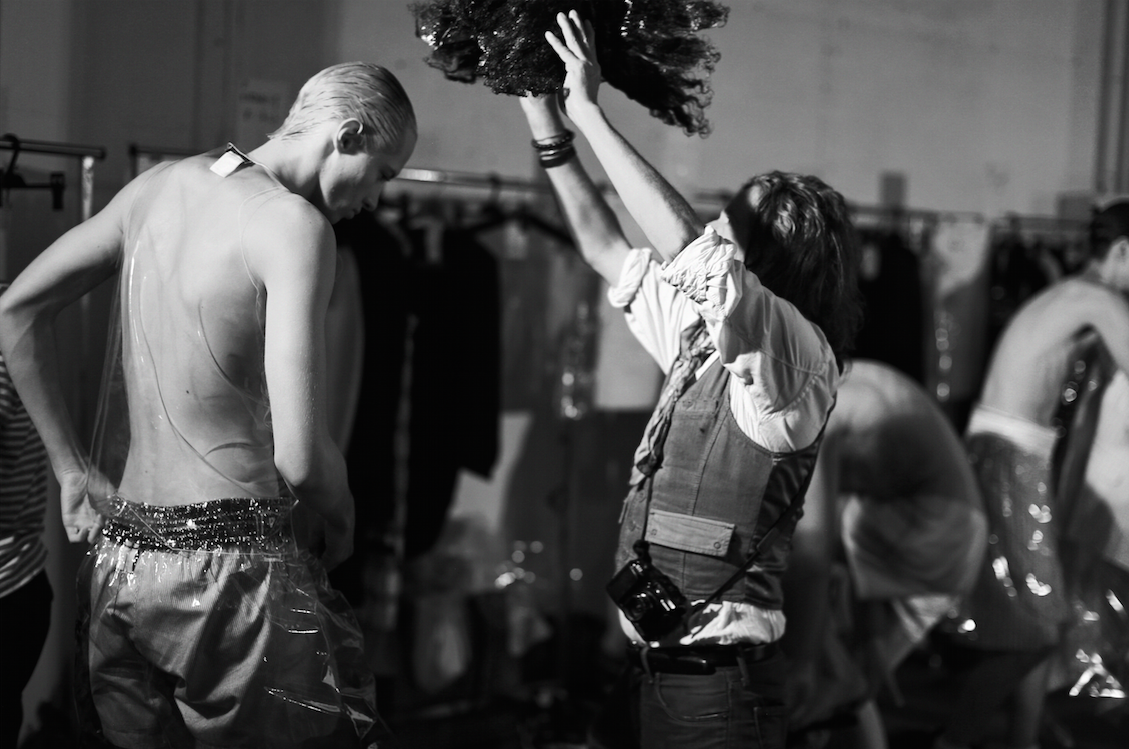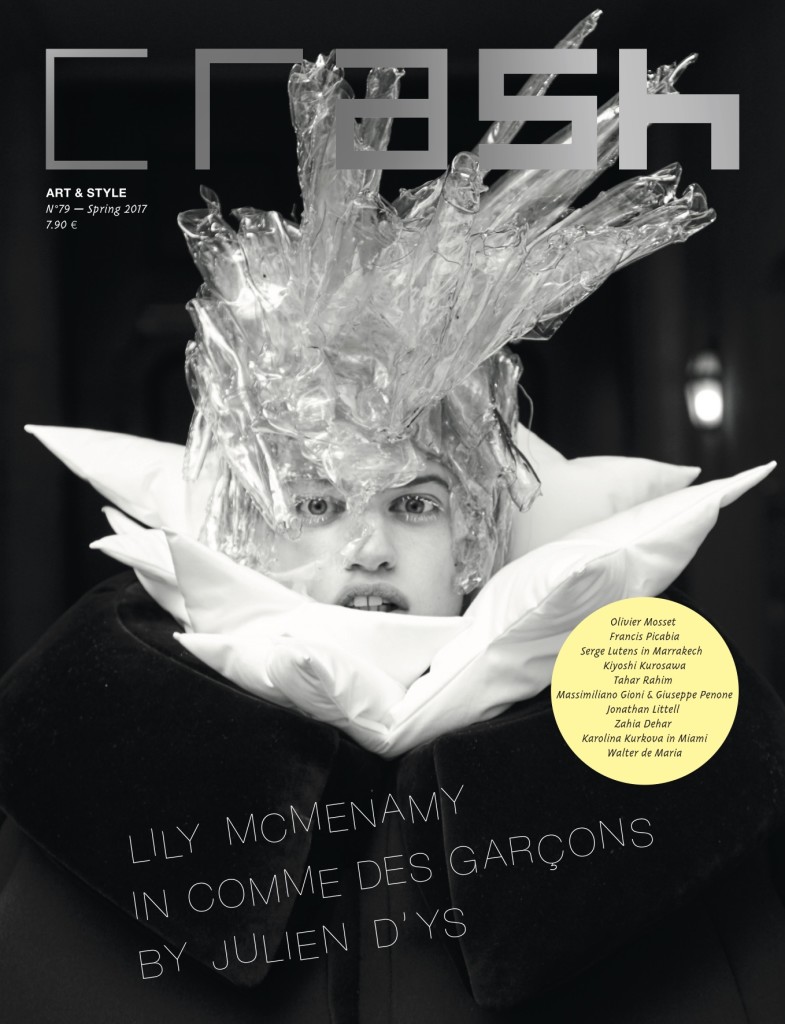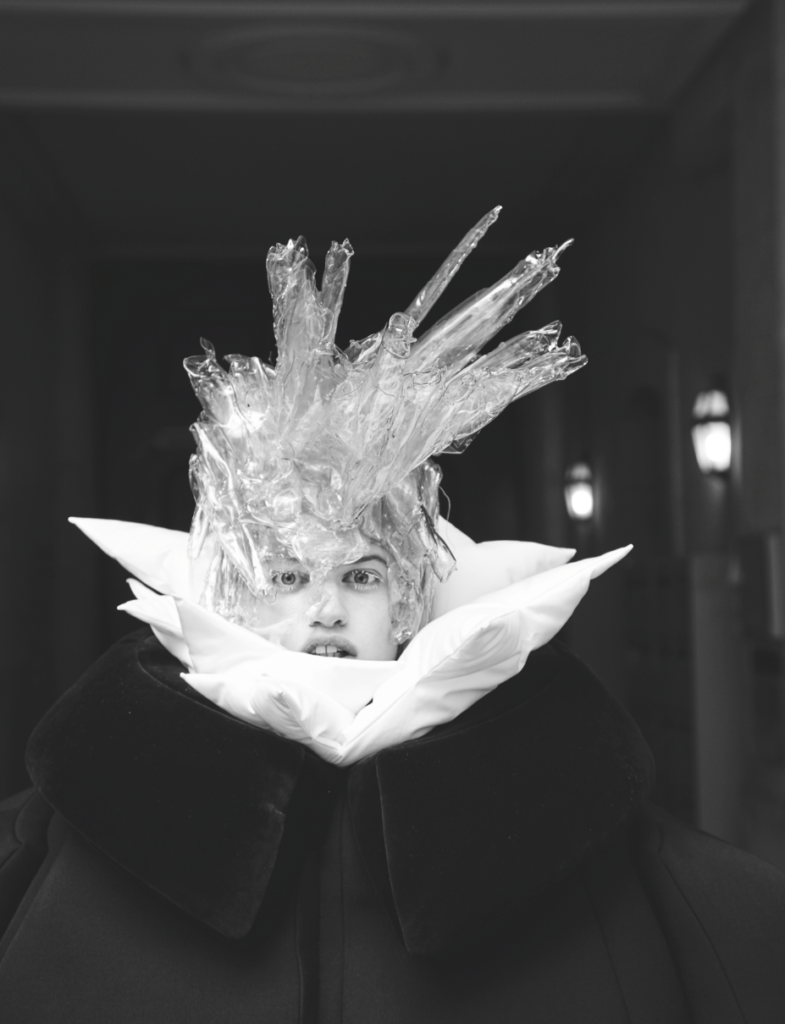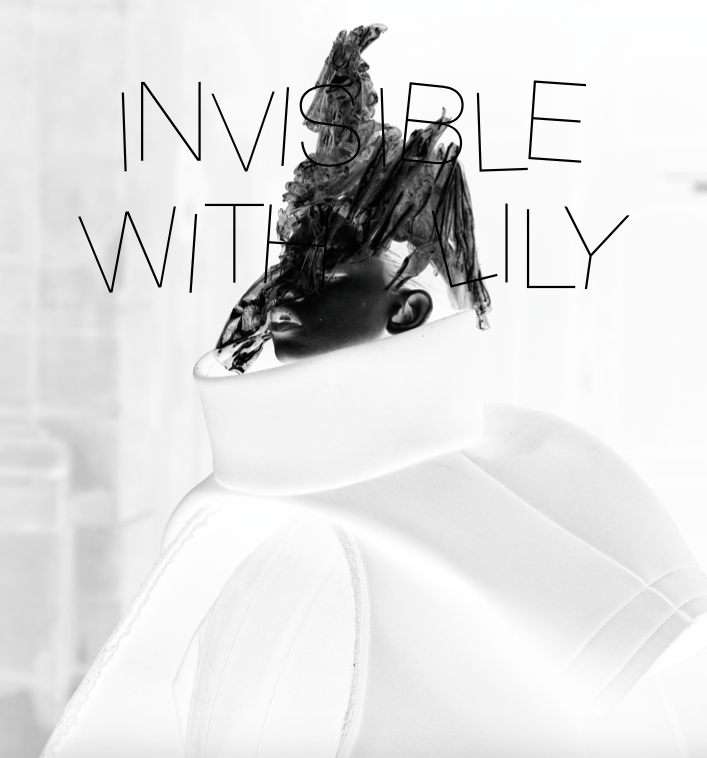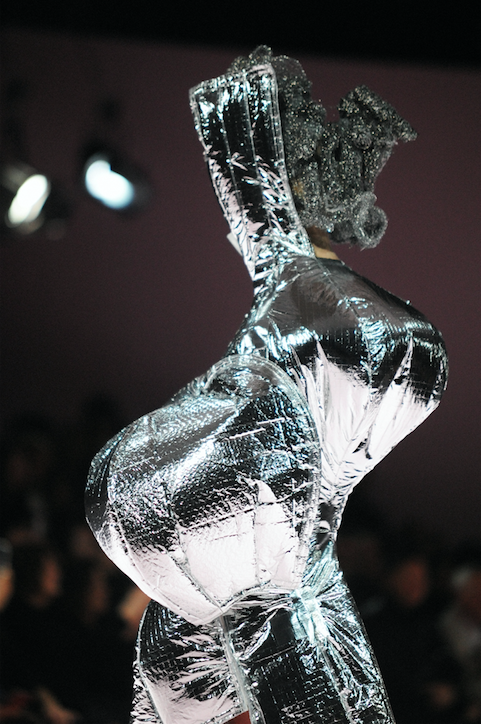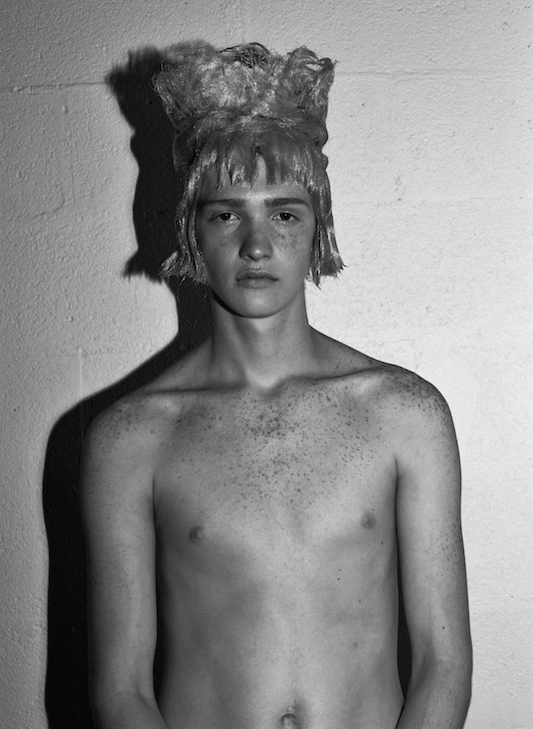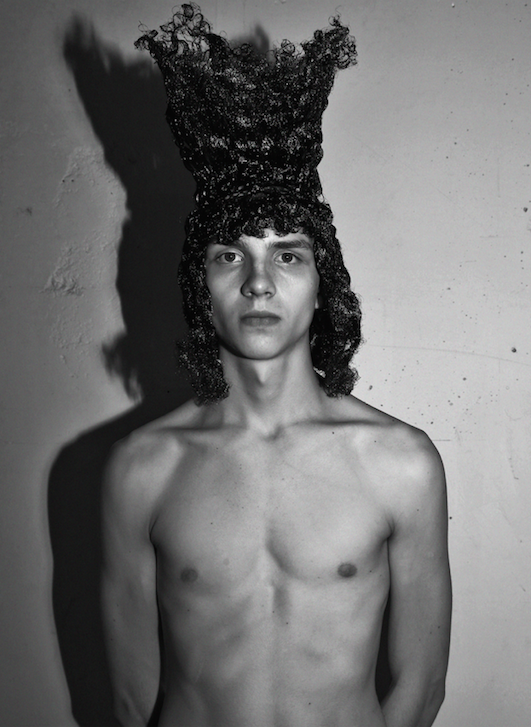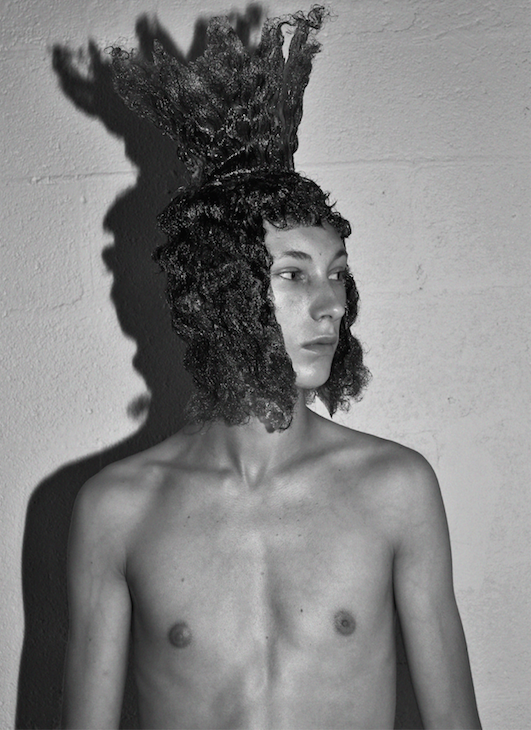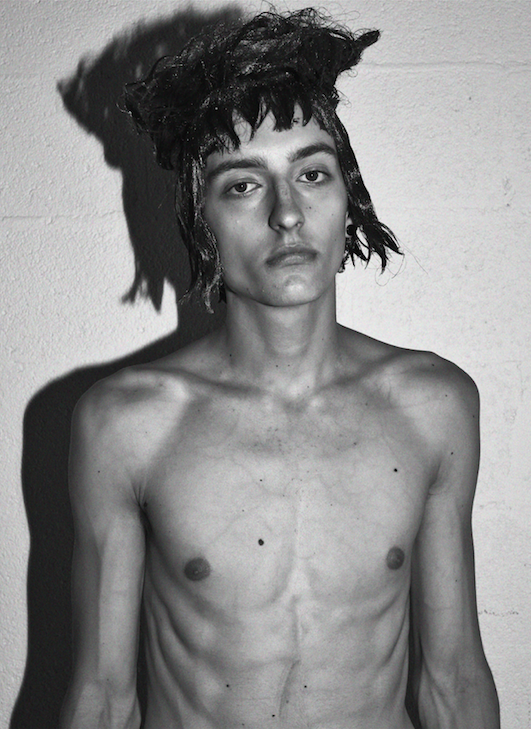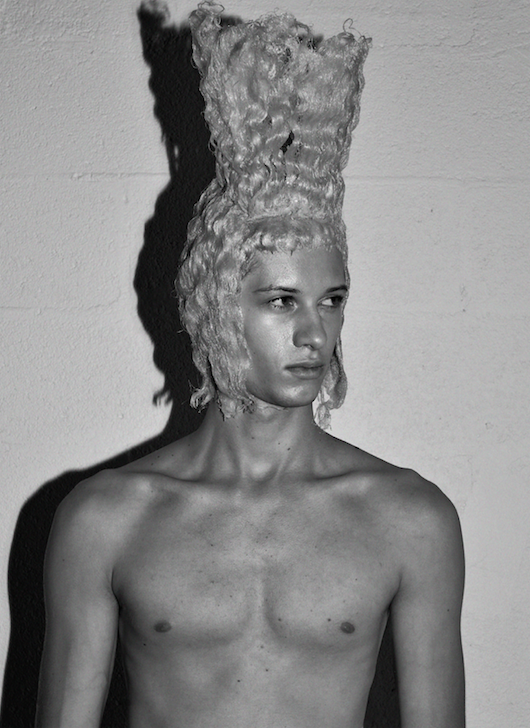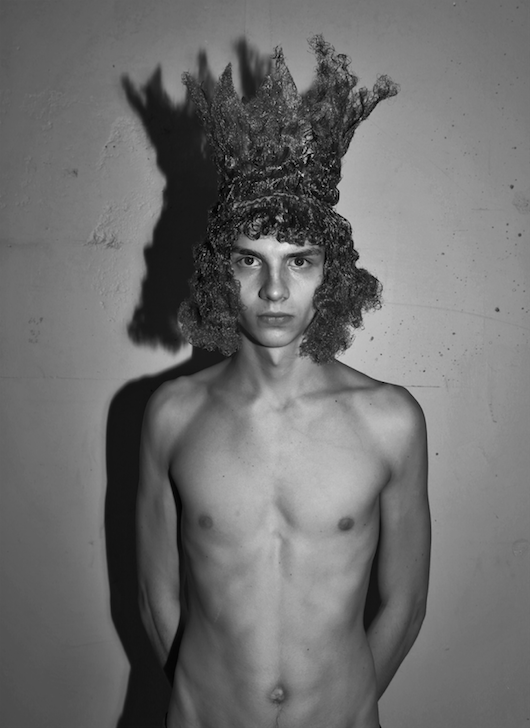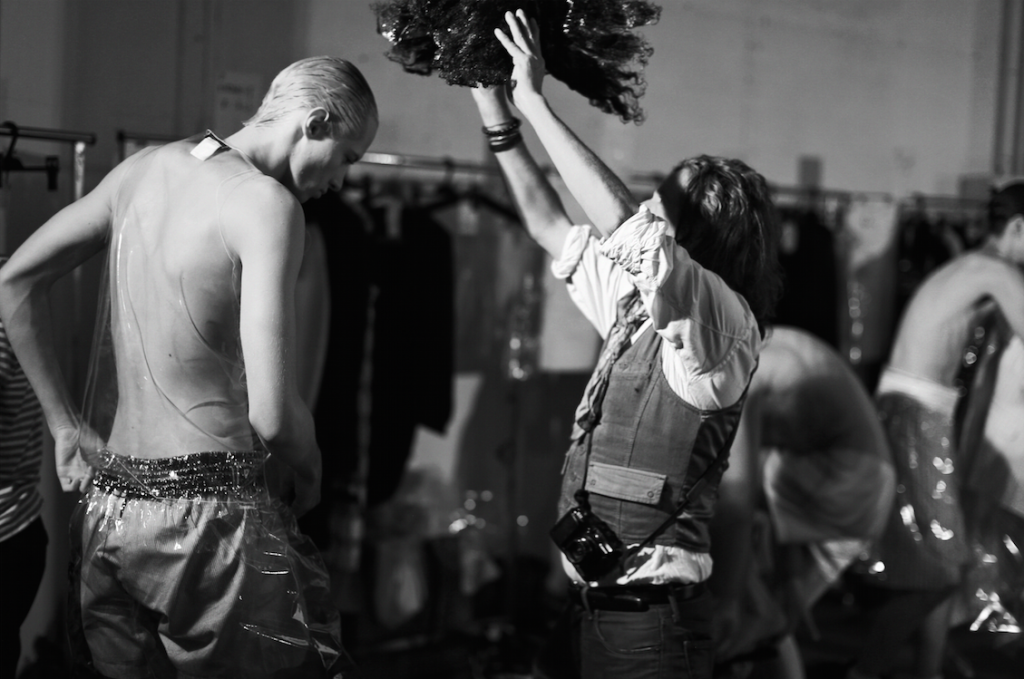
JULIEN D’YS – THE HAIRMASTER BEHIND COMME DES GARCONS
By Crash redaction
A king of the cut, Julien D’Ys is one of the most talented hair stylists of his generation. Learning his trade by working with many of the world’s top photographers, he continues to reinvent himself by adding new layers of imagination and aesthetics to his multifaceted career. For years he has joined forces with the revolutionary Rei Kawakubo to offer extravagant and technical designs for the Comme des Garçons men’s and women’s runway shows. He talks to us about his collaboration with the fashion giant, his passion for painting and the special project he produced with Crash entitled Naked Kings: a series of photographs shot by the talented İlker Akyol.
How did you get started in hair?
I get that question a lot… I was lucky enough to take part in a lot of expos when I was starting out, and I started working at studios right away. I see myself less as a hair stylist and more as an artist, because I always loved creating things ever since I was a kid. To be honest, hair was always just okay for me. What really interested me was the transformation. I started out at Jean-Louis David before joining the French Navy, where I also did hair on the Clémenceau aircraft carrier. After the military, I became Jean-Louis David’s assistant almost by accident and that’s how I started at the studios. If that hadn’t happened, I’m certain I would have stopped doing hair. Daniel Harlow was also very important for me: he gave me so much. He was a true rebel and I had the good fortune to work with him in the early 80s. He was fascinating to me, he was really a genius, a true rock star. Then I discovered the world of photography and that’s what I liked most. It’s also what kept me from quitting. I was able to work with the biggest photographers during the very creative era of the supermodels. I worked with Peter Lindbergh, Paolo Roversi, Steven Meisel…
Can you talk more about your collaborations with these legendary photographers?
They were all very different. Peter Lindbergh liked an extremely raw aesthetic. That’s why I started putting grease in models’ hair to give them that natural look that so many people have on the street nowadays. Together we introduced that natural look into photography, at a time when it wasn’t the easiest style to pull off. With Paolo Roversi, our work focused more on dreams and poetry. I’ve been something of a chameleon. I always did things my own way; no one ever forced me to do anything. I was lucky to have that freedom from the start and that it has continued until today. Nowadays, a lot of demands are placed on young artists. Every photographer I’ve worked with has been a real gentleman. That includes Irving Penn, Richard Avedon… Richard even had predictions for the future, and we worked together with Nicoletta Santoro on a story called “Paradise Lost” for Egoïste. My collaborations with photographers are about teamwork: it’s not just me and the photographer, there is also the stylist, the makeup artist… It’s like we’re a family. In the 90s, we often worked with the same girls, we traveled all around the world, to Deauville, Rome, Le Touquet, Arles… We were always on the road, especially with Peter Lindbergh, whom I worked with for several years.
Is it important for you to maintain your independence?
I was fortunate to receive support from a Japanese cosmetics house, Tamaris, who believed in me from the beginning. We formed a lasting, friendly relationship. I also worked with an agency in Paris, called Atlantis, which eventually had to close. At the time I was also working a lot in New York. The Japanese companies stuck by me and sponsored my first studio in Paris, on Rue de Braque. Painting is what I like most. I don’t limit myself to fashion and I think that’s why I’ve managed to keep pace with the business. I also pursue other creative activities, which gives me a fresh perspective on everything that’s happening and keeps me flooded with new ideas. That’s what’s happening right now with Comme des Garçons. Rei Kawakubo lets me work with her four times a year, on her men’s and women’s runway shows – which keep getting bigger and bigger. I helped usher in that ultra-new look along with her. Thanks to us, hair styles have become similar to sculpture. I think it’s harder for young people to get their start today than when I was just beginning, but it’s still possible to build a strong career because creation is still in demand. I try to keep creativity alive but it’s not always easy to find new ideas. Each new runway show is torturous, because I always have to find a way to reinvent myself. You can never rest on your laurels, and that goes even for professionals with decades of experience. I’m still just as nervous now as when I was first starting out.
Where do you get your inspiration?
From just about everywhere. A lot of it comes from film and historical periods stretching from mythology through the Renaissance to the 17th century. I always try to take elements from the past and update them for the present day. Current events also provide a source of inspiration, along with what I see in the street. It’s important because we really live on another planet in this business. So inspiration comes from anywhere, even from a word. For her last men’s runway show, Rei Kawakubo gave me just the word “crown” as her only indication. I racked my brain and buried myself in research, thinking at first that I would use actual crowns. But after talking to her, I realized that she wanted crowns of hair. Yet another challenge to tackle! So I finally came up with the idea of creating acrylic crowns that are similar to sculpture because they are solid. But I’m not saying any more about my secret technique for making them!
Can you say more about your lengthy collaboration with Rei Kawakubo and Comme des Garçons?
Rei is an extraordinary woman, a bit like Coco Chanel in her time: she’s a revolutionary, a fighter. She always wants to add something new to design. Her men’s collections are revolutionary compared to what everyone else is doing. Our kindred spirits explain why we have stayed together for so many years, even though it may not be apparent at first glance. She has given me so much over these twenty-five years because she always pushes me to take things even further. It’s important to surround yourself with people who stimulate you. With every runway show I take part in, whether it’s menswear or womenswear, I always try to do something different from what I did the last time. Rei, for her part, always manages to astonish me. Her clothes almost rise beyond the scope of fashion, her runway shows are theatrical in scale, and guests always expect to see something extraordinary. She’s someone I respect enormously. Sometimes we don’t even need words to understand each other. You have to remember that the first time I see the collection is the day before the show. She doesn’t show me anything ahead of time, so I can’t even take inspiration from the clothes; all the inspiration comes from me. I draw a lot in my notebooks, we trade sketches, messages, and it’s always a rewarding process.
Have you always kept notebooks of drawings?
Yes, I think I have over a hundred! I made sketches for every show that I worked on with Rei Kawakubo. She looks through them before the show and I also show her photos of my creations. If there is ever something she doesn’t like, I’m sure she wouldn’t hesitate to tell me – though I hope that day never comes! It still works for now, like a natural chemistry that you can’t explain. There was a time when the collections focused heavily on black and white, and so a few years ago, for womenswear, I thought it would be a good idea to change everything. So I talked to Adrian Joffe and told him I wanted more color. And that’s how I created something resembling swimming caps, with short cuts similar to bobs, all in super vivid colors like orange, yellow, and green. Joffe mentioned it to Rei, and she couldn’t believe it because the collection she had just designed was also extremely colorful. Almost the same thing happened with the “Chaos” collection for men: I saw guys in the street with man buns, and I decided I was going to reproduce that same shape, but turn it almost into a turban. She liked it, and it also went well with the collection, since it featured prints of 18th century tapestries. I always try to create images that encompass the whole body, from head to toe.
You do a lot of painting, as well. Does that influence your work?
I do a lot of oil painting, which is largely inspired by fashion. Since 1995 I’ve painted portraits of Linda Evangelista, Kristen McMenamy, Nadja Auermann, as well as Queen Elizabeth I, Egon Schiele… I would love to show my work independently of my fashion work. My work as an artist builds on my activity as a hair stylist. I started working with Peter Lindberg again. And with the help of makeup artist Stéphane Marais, whom I’ve worked with for years, we did a whole project on Kate Moss recently. I try to be fairly selective when I decide who to work with because I want to keep a family spirit.
Tell us about the photo project you prepared for this issue.
It’s the story of the Naked Kings. Like I was saying before, I started from the idea of crowns. Just before the runway show, the models were naked and so we took simple but very powerful portraits, in black and white, captured by İlker Akyol. This young photographer I’ve been working with for a while now tells the story of how the Comme des Garçons look is created, by pairing his portraits with his photographs of my drawings. There is something almost anarchistic about these naked kings, especially with the rigid mesh T-shirts contained in the collection. I also try to use painting to recreate the looks I design in real life. For example, I painted a portrait of Karlie Kloss using photos by Patrick Demarchelier. It’s an enormous painting! Maybe that will be my next project for you!
Have you ever thought about exhibiting your paintings?
I’ve never organized a proper exhibition. But lately I’ve started working with Azzedine Alaïa again. I put him on the same level as Rei Kawakubo. For me, they are the two most important figures in fashion right now. Alaïa is a true genius, and stunningly simple. He’s told me a lot of stories: about his early days, his life in attic rooms with the top models of his day, his club nights in Paris… Experiences that are very similar to my own. He’s someone I like a lot. If I ever put on an exhibition, I would love to have it in his gallery, even though I’ve never talked to him about it… I’ve only shown my paintings one time, across the street from the Comme des Garçons boutique on the Rue Saint Honoré. I set up an exhibition that lasted two months to show my sculpture work and some of my paintings: a large portrait of Kate Moss, Egon Schiele… It was a tiny exhibition, and there were only a few paintings. I’m not ready to part with them yet. I might sell them one day, but I’m not ready yet.
What are your thoughts on how the fashion and creative industries have changed since you first started out?
I think there are different eras. We went through the 80s, the 90s, the 2000s, just like we once saw the 50s, 60s, or 70s… Each of these eras has a specific look. Today’s woman is more about her natural charms, and hair has taken a back seat to makeup, it has almost become neutral. That’s why we sometimes emphasize hair during runway shows, even though creation seems to be growing in importance again. These are phenomena that come in waves. I think there will always be creativity; it’s just the way it is expressed that changes because everything goes so fast. I think fashion is becoming a business: production is becoming more important than creativity. But I still think people will always need creativity: even though our societies are facing uncertain political times right now, I think creativity represents our hope of overcoming. I view my activity like a gift from on high, sometimes I’m even amazed by what I do! I think there are young people everywhere whose lives have nothing to do with fashion, but who will manage to break through simply on the strength of their talent.
Do you work with any of the young artists you support to help them get started?
Not concretely, but I have taken part in seminars for young Japanese hair stylists in Paris. And instead of asking them to cut hair, I organized a clay sculpture workshop. You can achieve results you never expected in every discipline that involves working with your hands. For example, Ilker Akyol is a genius of photography in my eyes (he also does hair in New York), but he is just starting out. I use Instagram to discover young talent, like the 21-year-old from South Africa, Christopher Smith (@mechrissmith), who does some rather violent self-portraits. I reached out to see how he prepared his shots, and he told me he took them alone in his room. Technology is giving a big boost to creativity nowadays, and it helps young artists explore new tools and reach larger audiences. There are a lot of unknown people with extraordinary talent. At the same time, there are also a lot of high-placed figures in fashion who have none.
CRASH 77 – SEPTEMBER 2016 ISSUE
NAKED KINGS by Julien D’Ys, shot by Ilker Akyol







